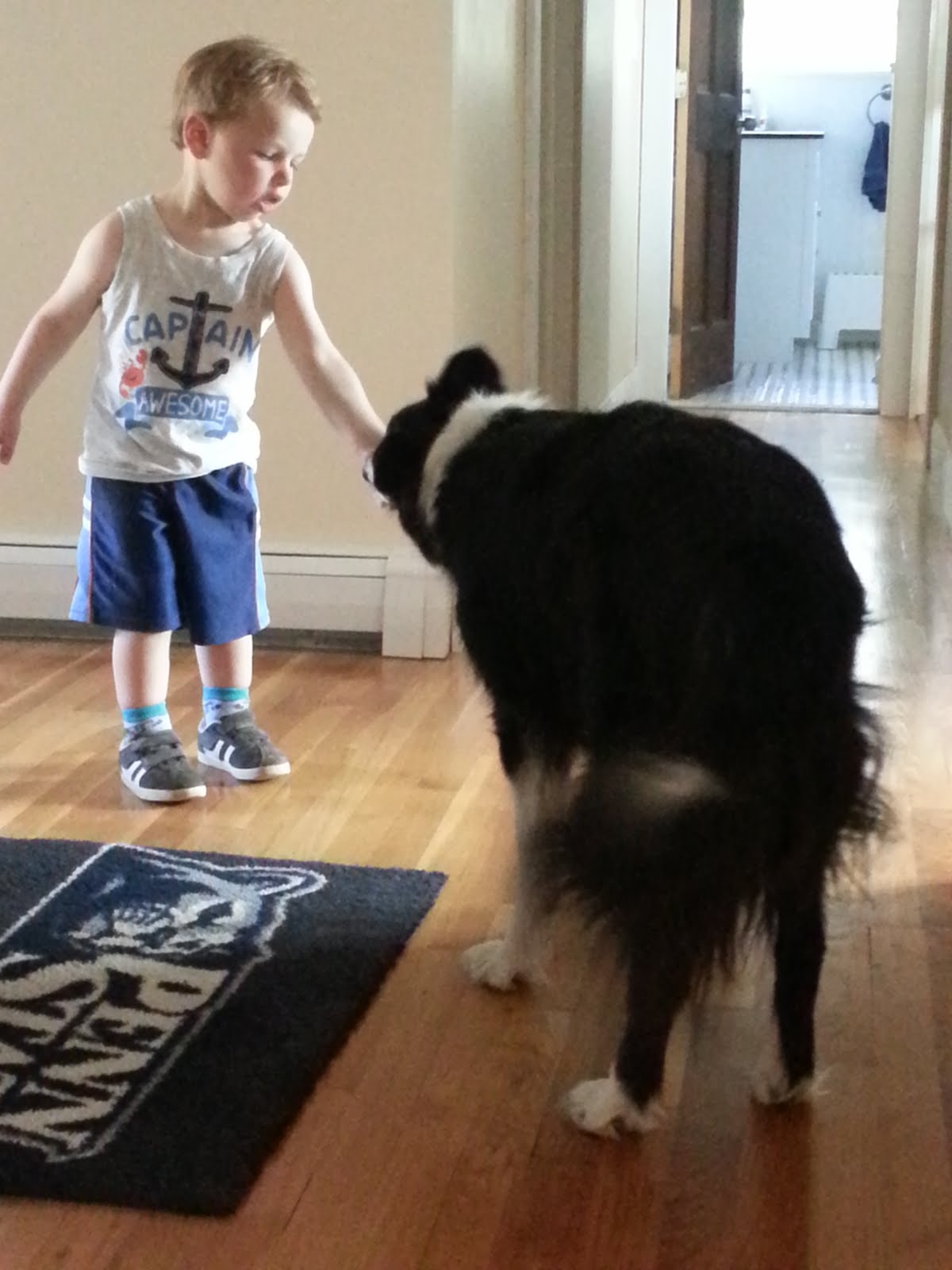

Life in another small town like all small towns...really
 I'm going to send you to the blog The Garden of Eaden, found on my sidebar. For my British friends, and those in that climate, Mr. Eade is from your side of the Pond. Everyone may want to check out his web site and seed shop. All kinds of information and fun.
I'm going to send you to the blog The Garden of Eaden, found on my sidebar. For my British friends, and those in that climate, Mr. Eade is from your side of the Pond. Everyone may want to check out his web site and seed shop. All kinds of information and fun. My one plant is big enough for my dog to dig a hole underneath it to cool off in. I think its time for me to put it to use.
My one plant is big enough for my dog to dig a hole underneath it to cool off in. I think its time for me to put it to use. If you look closely you will see the white posts from the electric fences that we use to divide the paddocks into even smaller grazing areas.
If you look closely you will see the white posts from the electric fences that we use to divide the paddocks into even smaller grazing areas. Every time we move the sheds on sleds, I try to place them where they can stay for two weeks, and to a place that I can see them from the house. Then I make as small a section of the paddock as I can, for the goats to move into, using the electric net fences. They are connected to the high tensile fence with a clip.
Every time we move the sheds on sleds, I try to place them where they can stay for two weeks, and to a place that I can see them from the house. Then I make as small a section of the paddock as I can, for the goats to move into, using the electric net fences. They are connected to the high tensile fence with a clip.  This is the way I do rotational grazing, and it works pretty well for giving the goats fresh pasture everyday.
This is the way I do rotational grazing, and it works pretty well for giving the goats fresh pasture everyday.  I don't move the goats to a new paddock daily. I just move enough of the netting fence so that the herd has enough new vegetation to keep them busy for a day. Then the next day I do it again.
I don't move the goats to a new paddock daily. I just move enough of the netting fence so that the herd has enough new vegetation to keep them busy for a day. Then the next day I do it again.  You can see the line of new food from where the fence was moved a few more feet, each day, in each of the photos. Each day the goats RUN to see the newest area I've opened for them. They all have their favorite food they go for on their first browse around. Then they come back and look again. Its like a buffet where you eat dessert first, and then end up with the boring stuff at the end, IF you are still hungry. We try to give them enough that they are happy, and leave plenty behind to start the next set of growth.
You can see the line of new food from where the fence was moved a few more feet, each day, in each of the photos. Each day the goats RUN to see the newest area I've opened for them. They all have their favorite food they go for on their first browse around. Then they come back and look again. Its like a buffet where you eat dessert first, and then end up with the boring stuff at the end, IF you are still hungry. We try to give them enough that they are happy, and leave plenty behind to start the next set of growth. These last pictures were taken two Thursdays after we started, and the electric netting fence was removed on Friday. The paddock was neatly trimmed, but with plenty of growth to continue growing for a future turn in a couple of months from now. And of course, the fields have been pretty evenly manured by the goats because of the rotational method we use, so that also keeps things growing.
These last pictures were taken two Thursdays after we started, and the electric netting fence was removed on Friday. The paddock was neatly trimmed, but with plenty of growth to continue growing for a future turn in a couple of months from now. And of course, the fields have been pretty evenly manured by the goats because of the rotational method we use, so that also keeps things growing. The goats are getting very little grain or hay in the barn. The nursing goats are getting hay and grain rations, but as the kids approach weaning, the nannies are also being weaned from this feed. As we hit the summer months, we will depend on good rotation and growth to keep the goats fat and happy!
The goats are getting very little grain or hay in the barn. The nursing goats are getting hay and grain rations, but as the kids approach weaning, the nannies are also being weaned from this feed. As we hit the summer months, we will depend on good rotation and growth to keep the goats fat and happy!
 Brees, on the right, with a collar and leash, getting his exercise with Kayla.
Brees, on the right, with a collar and leash, getting his exercise with Kayla.
 Julia has a more personal relationship with these kids ever since she saw Ziggy being born.
Julia has a more personal relationship with these kids ever since she saw Ziggy being born. She also knows that the kids will come to you if you just let them.
She also knows that the kids will come to you if you just let them.  Hannah worked on her goat relationship skills!
Hannah worked on her goat relationship skills!  Ziggy got more cuddles.
Ziggy got more cuddles.  "Yes Mom. We're with the goats. Just a few more minutes?"
"Yes Mom. We're with the goats. Just a few more minutes?" This week-end was one of those perfect ones to get work done outdoors, and what was I doing? In addition to getting some more of the garden planted, I was mowing the fence line, and cutting the paths across the field.
This week-end was one of those perfect ones to get work done outdoors, and what was I doing? In addition to getting some more of the garden planted, I was mowing the fence line, and cutting the paths across the field. I like doing it actually.
I like doing it actually.
 Once in a while, I do manage to look up, and have to stop to admire the view.
Once in a while, I do manage to look up, and have to stop to admire the view.  If I am lucky enough, my camera is in my pocket, and I can share the moment.
If I am lucky enough, my camera is in my pocket, and I can share the moment.  Right now, the foliage is coming in with every texture, hue, and shade.
Right now, the foliage is coming in with every texture, hue, and shade. After a lovely, working week-end like this, we're all dog tired.
After a lovely, working week-end like this, we're all dog tired. The candy tuft is a fairly fast spreading flower, that has a nice green foliage the rest of the year.
The candy tuft is a fairly fast spreading flower, that has a nice green foliage the rest of the year.  Red, white and purple for the prom! My neighbor getting ready to go.
Red, white and purple for the prom! My neighbor getting ready to go. The perennial of the year - Blue False Indigo-Baptisia australis .
The perennial of the year - Blue False Indigo-Baptisia australis . Looks like I will get lots of pods this year. After five years, this plant has really matured.
Looks like I will get lots of pods this year. After five years, this plant has really matured.

 Tizy is a long time friend, and past coworker of Hubs. He has a great sense of humor, and of experimentation, especially when it comes to foraging and the culinary arts. A few days ago I got this notice from him, and he is allowing me to pass on the news.
Tizy is a long time friend, and past coworker of Hubs. He has a great sense of humor, and of experimentation, especially when it comes to foraging and the culinary arts. A few days ago I got this notice from him, and he is allowing me to pass on the news.If you read the wild food books, they all say you need to boil milkweed in 2 or 3 changes of water to "remove the bitterness", but I've convinced myself that (at least for the milkweeds growing around here), there just ain't no bitterness to remove. Every time I've made them, I've snuck one after the first boiling, and there wasn't the slightest bitterness of any kind. If you Google "milkweeds", you'll see there's a fella in the Midwest who's spent a lot of time trying to get to the bottom of this alleged "bitterness" business (cuz his milkweeds aren't bitter either), and the best he could come up with is that maybe they're bitter somewhere, but it's probably one of those situations where the plant's are extremely sensitive to microclimate. If so, I live in a favored milkweed "appellation". The wild food books also tell you to wait until the water's fully boiling before dropping in the milkweed, but I suspect that's "hooey" as well. Next time, I'll throw caution to the wind and just boil them "regular" to see how they'll come out. I suspect there won't be any difference.
If you're on a quest to eradicate milkweed from your farm, eating them's a great way to do it.
Now before you go traipsing through the field for your milkweed, please be aware that there are many kinds, and parts can be toxic. Check out the links I found for good information and some interesting history also.
Identifies many milkweed plants. Its a large genus. http://en.wikipedia.org/wiki/AsclepiasInteresting stories here: http://www.woodrow.org/teachers/bi/2000/Ethnobotany/milkweed.html








